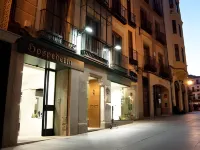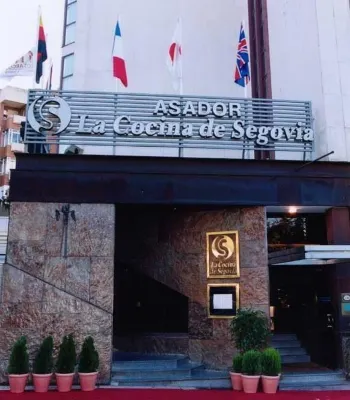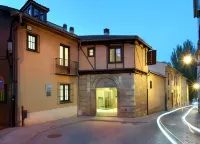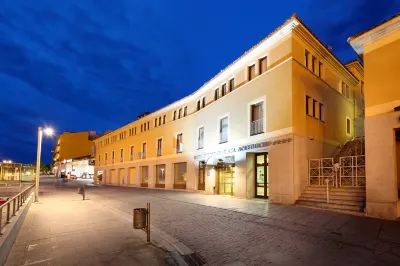
Hotel terbaik di Segovia
Masukkan tarikh perjalanan anda untuk menyemak harga dan ketersediaan terkini
Leret ke atas untuk melihat lagi
Tapis mengikut:
Penarafan bintang hotel
≤2345
Penapis Popular
Terbaik 4.5+Hebat 4.0+Bagus 3.5+Baik 3.0+63 hotel di Segovia
Pilih tarikh perjalanan anda untuk melihat harga terkini.
Paling Popular
Harga Terendah
Paling hampir ke Pusat Bandar
Mendapat Ulasan Terbaik



Hotel berhampiran Segovia
PPengguna Tetamu 2023.02.16
I have stayed here before and enjoyed my previous stay at the hotel and this wasn’t any different. As I was alone and staying just one night whilst travelling from the ferry in Santander to Málaga, I just needed somewhere clean and comfortable with a decent breakfast and that is exactly what I got for €50 (£44). The bathroom was good although the toilet was very close to the washbasin and tucked in behind one side but the shower was good with very hot water. Breakfast was good with a variety of cereals, eggs, ham, bread, yoghurt and fruit etc and the lady serving coffee was lovely and friendly. I will certainly stay here again, the location right on the Plaza Mayor could not be bettered.
Sangat Baik
110 ulasan
4.4/5
Harga bermula
RM 265
satu malam



Hotel berhampiran Segovia
PPengguna Tetamu 2023.11.07
Genial estancia, tanto por precio como por ubicación, dispone de todo tipo de comodidades para cocinar incluido en la misma habitación-apartamento. Dispone también de bañera y ducha, y la cama matrimonial grande y cómoda. Fuimos con nuestra mascota, un chihuahua al que me pusieron bebedero y comedero. Volveremos!
Sangat Baik
20 ulasan
4.5/5
Harga bermula
RM 329
satu malam



Hotel berhampiran Segovia
2024.02.25
We arrived in Segovia after dark and went to the hotel after eating roast suckling pig. We booked a room with a balcony, but the front desk mistakenly gave us an interior-facing room, and we quickly changed it after negotiation. The room facilities are slightly simple, but the balcony has a great view, with the ”Disney” castle not far away. Breakfast is a buffet and costs only 9 euros per person. The hotel is very cost-effective. In the morning I was surprised to see a bunch of hot air balloons rising from the fields. After breakfast, we walked down the road near the hotel to the lawn by the river and looked up at the castle. We came up (without going back) and visited the inside of the castle (it doesn’t open until 10 am). We returned to the hotel to rest for a while and checked out at 12 o’clock.
Sangat Baik
72 ulasan
4.4/5
Harga bermula
RM 239
satu malam

Anda Mungkin Menyukai
Hotel Dengan SarapanHotel Dengan Bilik BerkembarHotel Dengan 1 Katil DoubleHotel Dengan Kolam RenangHotel Dengan Pembatalan Percuma



Hotel berhampiran Segovia
2024.03.05
The apartments are well equipped and well decorated. It makes you feel at home. The price is fair and worth it. The location is privileged, right at the commercial street. Furthermore, the entire staff is kind and helpful. Additionally, I requested a taxi to reach the city. Antonio, the driver, made sure the trip was safe and pleasant.
Sangat Baik
103 ulasan
4.4/5
Harga bermula
RM 223
satu malam



Hotel berhampiran Segovia
KKamiaodabaobao 2023.09.20
這一家酒店硬件設施過硬,洗漱用品質量好,但是注意牙膏 牙刷 拖鞋需要自行攜帶。工作人員服務熱情,前台的幾位工作人員盡職盡責。酒店位於古城中心區域,前往各個景點步行即可到達。如果是坐火車前往Segovia的旅客一定注意自己列車停靠的站台,如果列車停靠Segovia guiomar 車站,那就要注意了,這個車站距離市區較遠,且公共交通等候時間較長,車站有12路公交車可以到達酒店,但是中午的等候時間很長,會間隔一小時。火車站門口會有出租車但不一定一直會有,打車到酒店很方便。如果早上退房去火車站最好乘坐出租車,公交車等候時間長,從酒店出門左轉 上主路左轉,在一個小環島處有出租車站,早上會有車等候。西班牙火車站需要安檢,刀具 剪刀是不可以攜帶的,在西班牙乘坐火車一定要提前到達車站。
Sangat Baik
64 ulasan
4.5/5
Harga bermula
RM 293
satu malam



Hotel berhampiran Segovia
Dengan penginapan di Hotel Spa La Casa Mudéjar, anda akan berada betul-betul di tengah Segovia, berdekatan dengan Corpus Christi Convent dan Plaza Mayor. Hotel spa ini berada 0.2 km dari Juan Bravo Theater dan 0.2 km dari Casa de los Picos.
Manjakan diri anda di spa yang menawarkan urut dan rawatan badan. Anda tentu sekali akan menghargai kemudahan rekreasi, yang termasuk tab spa dan sauna. Ciri-ciri tambahan di hotel ini termasuklah akses Internet wayarles percuma, perkhidmatan rencam dan perkhidmatan perkahwinan.
Menjamu selera di El Fogon Sefardi, salah sebuah daripada 2 restoran di hotel, atau nikmatinya dalam bilik dengan menggunakan perkhidmatan bilik (semasa waktu terhad). Snek juga tersedia di kedai kopi atau kafe. Akhiri hari anda dengan menikmati minuman di bar/ruang istirahat. Sarapan bufet disediakan pada setiap hari dari 8:30 hingga 10:00 dengan dikenakan bayaran.
Kemudahan yang ditampilkan adalah termasuk akses Internet (berwayar) kelajuan tinggi percuma, pusat perniagaan dan perkhidmatan pencucian kering/dobi. Ada rancangan acara di Segovia? hotel ini mempunyai ruang berukuran 538 kaki persegi (50 meter persegi) yang terdiri daripada ruang persidangan dan 2 bilik mesyuarat.
Inaplah di salah satu daripada 42 bilik tamu yang menampilkan Televisyen Plasma. Akses Internet berwayar dan wayarles percuma disediakan untuk membolehkan anda sentiasa berhubung, sedangkan digital disediakan untuk hiburan anda. Bilik mandi persendirian dengan tab mandi atau pancuran menampilkan hulu semburan mandi hujan dan kelengkapan dandanan diri percuma. Kemudahan yang disediakan merangkumi telefon serta peti besi dan meja.
Bagus
72 ulasan
4.1/5
Harga bermula
RM 259
satu malam



Hotel berhampiran Segovia
Dengan penginapan dari Aralso Santa Isabel di Segovia, anda akan berada hanya 3 minit berjalan kaki dari Gereja Santa Eulalia dan 6 minit berjalan kaki dari Biara San Antonio El Real. Hostal ini berada 0.8 km dari Botanic Garden Segovia dan 1.4 km dari Gereja San Justo.
Gunakan kemudahan sesuai yang disediakan, yang termasuk akses Internet wayarles percuma dan bantuan pelancongan/tiket.
Kemudahan yang ditampilkan adalah termasuk kakitangan berbilang bahasa dan tempat simpanan bagasi. Tempat letak kenderaan sendiri percuma terdapat di tapak hartanah.
Selesakan diri anda di salah sebuah bilik tamu, yang menampilkan dapur dengan dapur dan ketuhar gelombang mikro. Katil anda disediakan dengan gebar bulu kapas dan peralatan tempat tidur premium. TV Pintar 32-inci dengan program digital disediakan untuk hiburan anda, manakala akses Internet wayarles percuma membolehkan anda sentiasa berhubung. Kemudahan yang disediakan merangkumi cerek elektrik, dan anda juga boleh meminta untuk katil bayi/kot (percuma).
Cemerlang
3 ulasan
4.7/5
Harga bermula
RM 928
satu malam



Hotel berhampiran Segovia
PPengguna Tetamu 2023.12.12
Ha sido una buena elección, está a una distancia cómoda para visitar la ciudad sin necesidad de coche. La atención muy buena, el desayuno más que bien, las habitaciones son notables en comodidad. Quiero resaltar la deferencia habida, puesto que se nos olvidó alguna prenda y no demoraron nada en enviárnosla al domicilio.
Bagus
50 ulasan
4.0/5
Harga bermula
RM 342
satu malam



Hotel berhampiran Segovia
2023.10.11
This is a gem of a hotel in the northern part of the centre of Segovia (the quieter part, while still within easy reach of the main sights of the city, especially the Alcazar). It is housed in a 16th century building, but with all mod cons and with its own car park, which is very handy when travelling around Spain! It has no restaurant (there are plenty of good places to eat within a few minutes' walk), but it has an excellently-stocked breakfast buffet at a small extra cost. I have to mention Natalia on the reception desk, who was very friendly and helpful with advice and with our luggage! Thank you, Natalia! One point to note about Segovia: the Roman aqueduct is surely one of the wonders of the modern world! Built almost 2,000 years ago and still intact!
Bagus
72 ulasan
4.2/5
Harga bermula
RM 239
satu malam



Hotel berhampiran Segovia
PPengguna Tetamu 2021.12.31
Stayed 1 night at this hotel but was disappointed thoroughly. It started with the bed... we had selected a king-size bed while booking and what we got was a double bed. Not really the best choice when you are traveling with your husband. On top of that there was another single bed in the room. So, we got a room with 3, yes THREE, beds !!! There was even a small bench inside the room. The property is old and the rooms are also very old. No bath robes our slippers were provided. The bathroom had a bathtub and a bidet. The room service menu had very limited options. The room had a nice view of the aqueduct and that was the best part about it. The location was great with plenty of bars and restaurants around. The check-in was smooth and the staff were helpful.
Sangat Baik
103 ulasan
4.3/5
Harga bermula
RM 314
satu malam
Hotel popular di Segovia
Lihat semua
Pilih daripada senarai hotel terlaris bulan lalu
No.1
4.3/5
84 ulasanHotel San Antonio El Real
Hotel di Segovia
"Penginapan yang hebat!""Lokasi strategik"
Pilih tarikh untuk melihat hargaNo.2
3.8/5
63 ulasanHotel ELE Acueducto
Hotel di Segovia
"Good Location"
Pilih tarikh untuk melihat hargaNo.3
4.2/5
71 ulasanHotel Cándido
Hotel di Segovia
"Good Location"
Pilih tarikh untuk melihat hargaNo.4
4.2/5
44 ulasanParador de Segovia
Hotel di Segovia
"Pemandangan baik"
Pilih tarikh untuk melihat hargaNo.5
4.6/5
116 ulasanÁurea Convento Capuchinos by Eurostars Hotel Company
Hotel di Segovia
"Pemandangan baik"
Pilih tarikh untuk melihat hargaNo.6
4.0/5
61 ulasanHotel Corregidor
Hotel di Segovia
"Good Location"
Pilih tarikh untuk melihat hargaUlasan tetamu tentang tempat menarik di Segovia
Terokai destinasi yang wajib anda lawati di Segovia dan pilih hotel dekat untuk keselesaan terbaik
Aqueduct of Segovia
旅旅の径Segóvia, Spain, the most marked and well-known landscape, not the "Ancient Roman Grand Aqueduct". During the ancient Roman period of Turazhen the Great (AD 53-117), in order to introduce the water of the Frio River 18 kilometers away into the city of Segolia, the canal was dug and aqueducts were built to attract water into the city. The aqueduct is 813 meters long and is made of dry khaki granite (without mortar), which is strong and unusual. The aqueduct is 813 meters long and 128 towering columns support double-layered 148 arches. The top of the sink is a canal, more than 30 meters above the ground. The initial section standard 30X30cm was repaired at the end of the 15th century and was converted into a cement tank around 1930, and has been maintained and used since then. The Da Aqueduct has become the city symbol of Segovia. The city emblem and flag of Segovia, and the image of the Da Aqueduct is in the center. In 1985, the ancient city of Segovia + ancient Roman Grand Aqueduct was listed as a World Heritage Site. The current Grand Aqueduct stands at the southern end of the core tourist area of Segovia; the south side is the parking lot (no vehicles can enter the core tourist area), and the north side is the Grand Plaza and the visitor center. The tourists coming and going, hustle and bustle, looking up, queuing for pictures, are all impressed by the unique beautiful scenery.
Alcazar of Segovia
ZZar ChiOne of the best activities that I love to do in Segovia . Soo lovely
Catedral de Segovia
旅旅の径The Segovia Cathedral, which stands at the highest point of the ancient city of Segovia, has won the reputation of "the lady in the church" for its elegant shape. In 1520, the old Romanesque church on the original site was burned in the fire of war; During the reign of Carlos V, construction of the new church began in 1525, taking nearly 200 years to complete. As the latest Gothic church in Spain, the Cathedral of Segovia is a classic work of late Gothic architecture. The main tower of the Byzantine 88-meter-high clock tower is directly piercing the sky, the Roman-style arches are magnificent, the Gothic spires are scattered, the towering main tower is in line with the many small spires scattered, and the flowery appearance of the "lady" is more "majesty"... Mayor Square in front of the church, The tourists were excited to take the cathedral as the background.
Plaza Mayor
旅旅の径Built in 1610, Majoor Square is located in the center of the city, is the largest of the N squares in the ancient city of Segovia. The spacious square, the bright blue slabs highlight the vicissitudes, the simple iron pavilion sits at the C position, the surrounding shops are in scale, and the tourists who wear the flow look around with enthusiasm. The square is surrounded by exquisite buildings, the Juan Bravo Theatre, which was completed in East-1917 and has a pink exterior wall, the Segovia Cathedral, which was built in West-1678 and has the reputation of "the lady in the church", and the St. Miguel Church, which was rebuilt in South-1558 and has a red spire of earth. North-1610 and the square at the same time, the bright yellow city hall... colorful colors, diverse styles, each other interesting, shining.
Iglesia de San Martin
旅旅の径The Church of St. Martin, located in the center of the old town of Segovia, attracts visitors with its typical Mudhar style. The Church of St. Martin is located in the Moorish Mosque in its early years, and the Mudhar "mud tank" style; The 12th century was converted into a Catholic church, and the architectural style presents a high integration of European and Arab culture... The bell tower is still the square tower of the mosque, and the church nouveau combines the Mudhar style of the interlocking tower and the arched tower with the Roman-style semicircular arch. The top of the tower and the gate of the church are Gothic, Roman-style arched corridors, and the pillar sculptures of each Roman column have different exquisite patterns. The small St. Martin's Church, the epitome of the multicultural blend of the ancient city of Segovia, is worth a look.
Segovia Saint Martin Square
旅旅の径Located in the heart of the old town of Segovia, St. Martin's Square is small in size and not small in charm. The square, shaped like a right-angle triangle, is located in the 12th century St. Martin's Church (named after the square), which in typical Mudhar style became the epitome of the multicultural blend of the ancient city. Two right-angled positions are many residential buildings, restaurants and bars facing the street, attracting many tourists to stop and taste. Two sculptures stand prominently in the center of the square. A bronze sculpture - the monument of Segovia hero Juan Bravo, Bravo holding a military flag and a sword in one hand, heroic spirit rushed to his face; a gray-white stone sculpture - the sphinx of European beauty, which has a unique charm. Tip: Juan Bravo, Segovia’s urban hero, led the urban uprising against the tyranny of the king in 1520 and was captured and sacrificed in 1521. In honor of Juan Bravo, the Juan Bravo Theatre was established in Mayor Square in 1917 and bronze statues were erected in St. Martin's Square in 1921.
Soalan Lazim Tentang Hotel Segovia
Apakah hotel yang popular di ?
mempunyai banyak hotel yang popular. Sama ada anda melancong atas urusan perniagaan ataupun bercuti, Hotel San Antonio El Real, Hotel ELE Acueducto dan Hotel Cándido merupakan hotel pilihan. Berapakah harga purata untuk hotel di ?
Bagi hotel di , harga purata pada hari bekerja ialah RM 509, harga purata pada hujung minggu (Jumaat–Sabtu) ialahRM 628.Manakah hotel mewah di yang disyorkan?
mempunyai banyak hotel mewah dengan gaya berlainan. Áurea Convento Capuchinos by Eurostars Hotel Company adalah sangat popular. Manakah hotel di yang menyediakan sarapan pagi berkualiti tinggi?
Áurea Convento Capuchinos by Eurostars Hotel Company,Hotel San Antonio El Real dan Hotel Cándido menyediakan sarapan pagi berkualiti tinggi. Mulakan hari anda dengan sarapan pagi yang enak!Manakah hotel di yang menyediakan kemudahan kecergasan?
Hotel San Antonio El Real, Hotel Cándido dan Exe Casa de Los Linajes menyediakan kemudahan kecergasan. Penuhi keperluan kecergasan anda walaupun anda sedang melancong!Manakah hotel di yang mempunyai kolam renang?
Hotel Cándido, Exe Casa de Los Linajes dan Los Arcos ialah hotel yang mempunyai kolam renang. Menginaplah di mana-mana satu hotel ini untuk berseronok di kolam renang!Manakah hotel di yang menyediakan Wi-Fi percuma?
Sama ada anda melancong atas urusan perniagaan ataupun bercuti, sambungan Internet merupakan suatu kepentingan bagi perjalanan itu. Hotel San Antonio El Real, Hotel ELE Acueducto dan Hotel Cándido ialah hotel popular yang menyediakan Wi-Fi percuma. Manakah hotel di menawarkan perkhidmatan ulang-alik lapangan terbang?
Tidak kenal dengan ? Hotel San Antonio El Real, Hotel Cándido dan Exe Casa de Los Linajes menyediakan khidmat angkut lapangan terbang. Manakah hotel di mempunyai spa yang berbaloi untuk dialami?
Berasa letih selepas perjalanan? Hotel San Antonio El Real, Hotel Cándido dan Eurostars Plaza Acueducto menyediakan khidmat spa bertaraf tinggi. Apakah tawaran hotel yang tersedia di ?
Trip.com menyediakan pelbagai promosi dan diskaun untuk pengguna sepanjang tahun. Anda boleh semak halaman promosi untuk melihat promosi yang tersedia di Trip.com.Maklumat Hotel Pelancong
| Harga Tertinggi | RM 4,899 |
|---|---|
| Harga Terendah | RM 165 |
| Bilangan Ulasan | 1,391 |
| Bilangan Hotel | 157 |
| Harga Purata (Hari Bekerja) | RM 509 |
| Harga Purata (Hujung Minggu) | RM 628 |